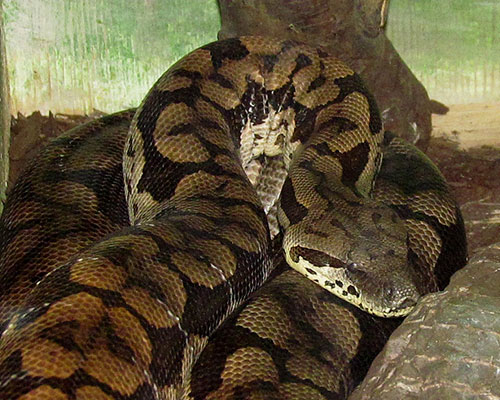
Difficulty: Intermediate
- Size: This is a large species and requires a custom enclosure size
- Heavy-bodied: Adults of this species may be difficult for some to lift
- Humidity: This species has higher humidity requirements
Adult Size
- 5 to 7 feet (1.5 to 2.1 meters)
- Females tend to be on the larger end
Life Cycle
- Average Lifespan: 10-20 years
- Sexual Maturity: 3-5 years
- Growth Rate: May take 5 years to reach adult size
-
- Viviparous - Live Birth
Enclosure Size
- 6x2 feet minimum
- Bigger is always better for these semi-arboreal snakes. Be sure to maintain necessary environmental conditions.
Husbandry Values
- Temperature:
- Ambient: 75-80°F (23.8-26.6°C)
- Basking: 88-90°F (31.1-32.2°C)
- The basking area should never exceed 95°F (35°C)
- Humidity: 40-50% (50-60% while in shed)
- Lighting: No specific requirements
- UV Light can be beneficial
Diet
- Carnivore: Rodents, May enjoy chicks
- Larger adults commonly feed on young rabbits
Behavior Notes
- Semi-Arboreal: Young snakes in particular enjoy climbing
- Temperament: Captive bred species are usually docile & friendly
- Ambush predator- This species hunts by surprising and wrapping its prey
***These care sheets assume that you understand the basics of snake care & husbandry.
If you are a new snake owner, it is recommended that you read our articles on general reptile care and then fine tune the requirements for the specific species you are interested in.
Habitat
Dumeril’s boas are native to coastal and southern Madagascar, inhabiting forests and grasslands with relatively low annual precipitation. It has been found at elevations up to 4265’ (1300m, iucnredlist.org). It is a ground-dwelling species, with patterning that allows it to blend in with leaf litter and other ground detritus.
This drier (but still coastal) habitat accounts for the Dumeril’s boa’s lower humidity requirements compared to other boa species. When raising its humidity (particularly when your snake is in shed), be sure that it still receives adequate ventilation.
Feeding
This species is carnivorous and feeds on rodents, although they are reportedly very fond of chicks as well. Feeding a rodent that is big around as the snake’s girth an average of once a week is a fine guideline here. Monitor the snake’s weight—as your boa reaches adulthood, you may feed less frequently to avoid obesity. A full-grown adult may do well eating about every 12-14 days, depending on food size.
References
- Dumeril’s boa, IUCN redlist https://www.iucnredlist.org/species/282/13054798
Photo Credit
- Banner- Marwell Zoo. https://www.marwell.org.uk/zoo/explore/animals/25/dumerils-ground-boa
- Article body- Seneca Park Zoo https://senecaparkzoo.org/animal-pages/dumerils-ground-boa/
